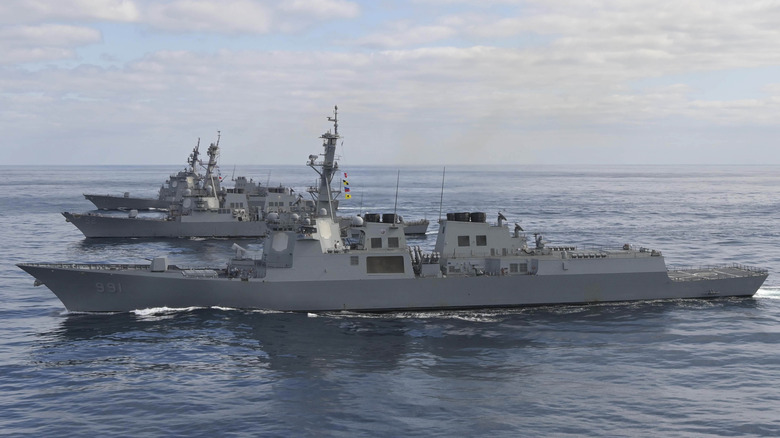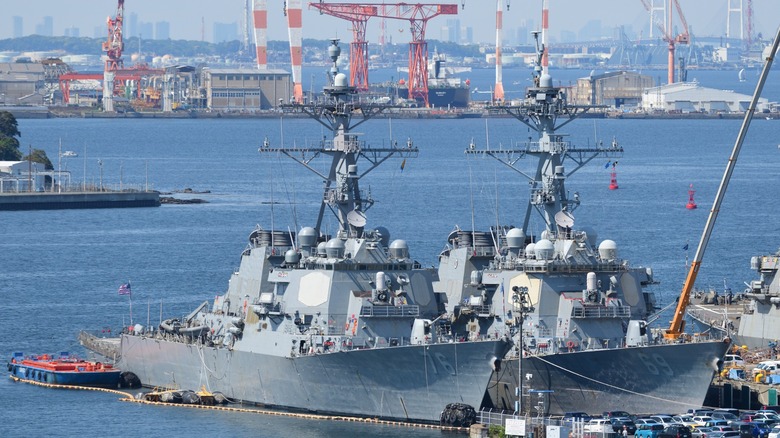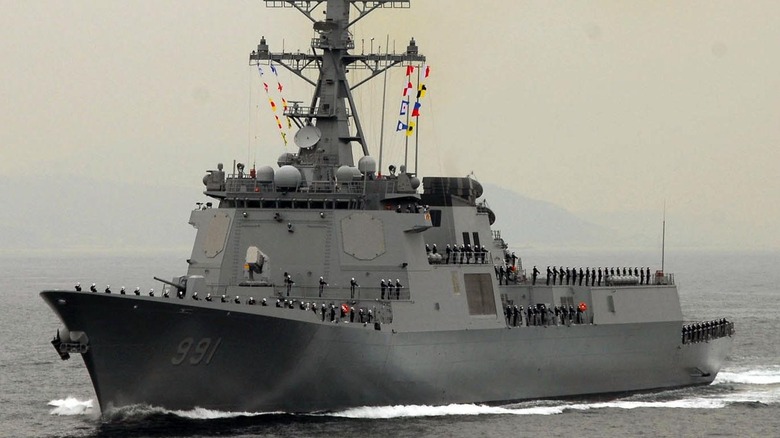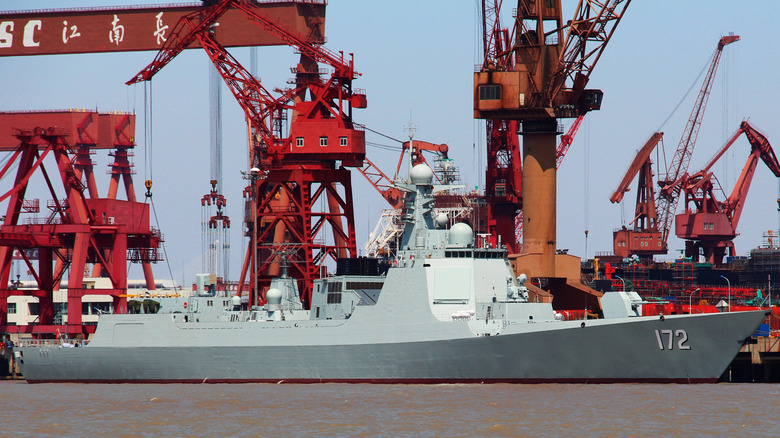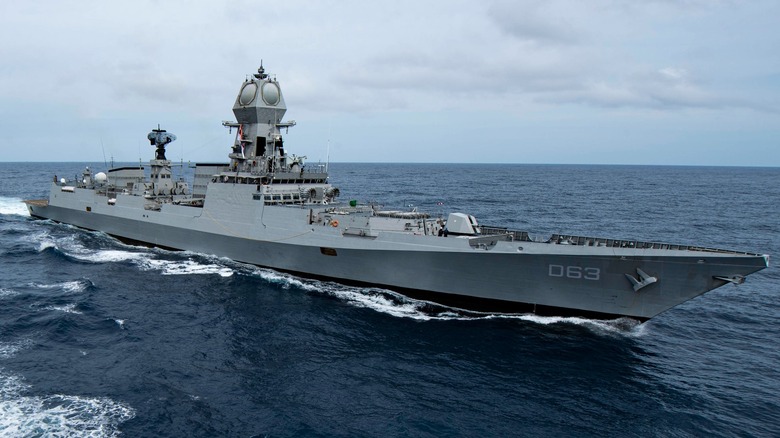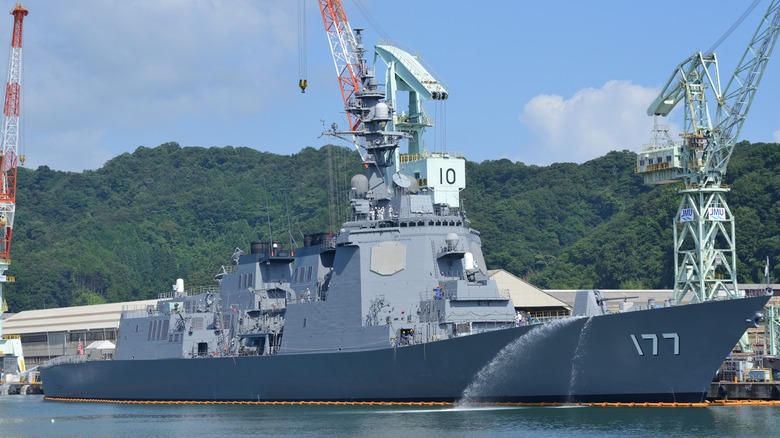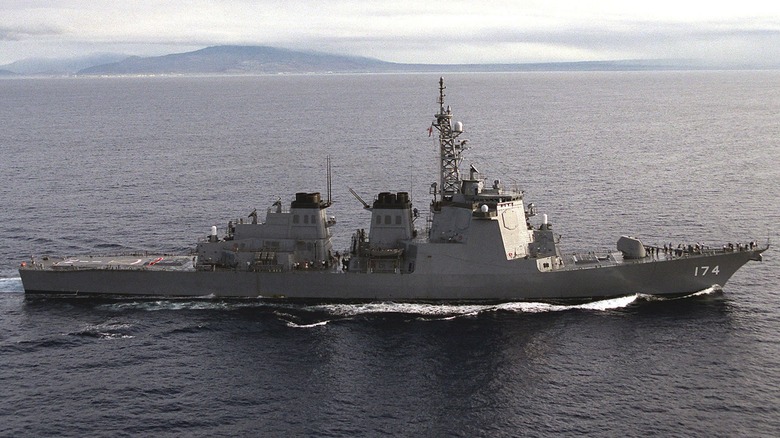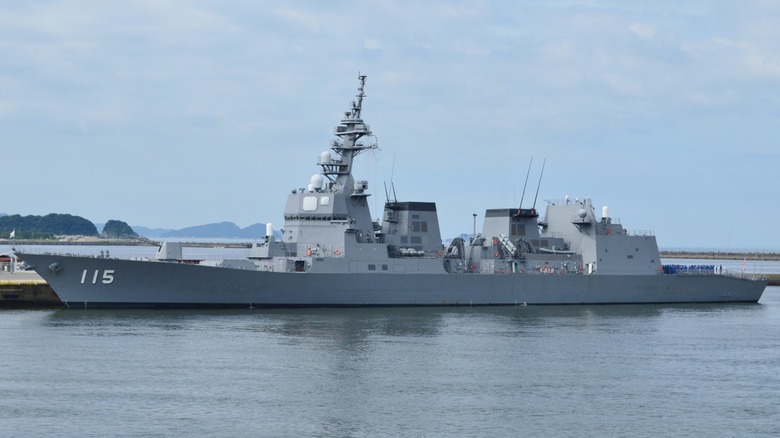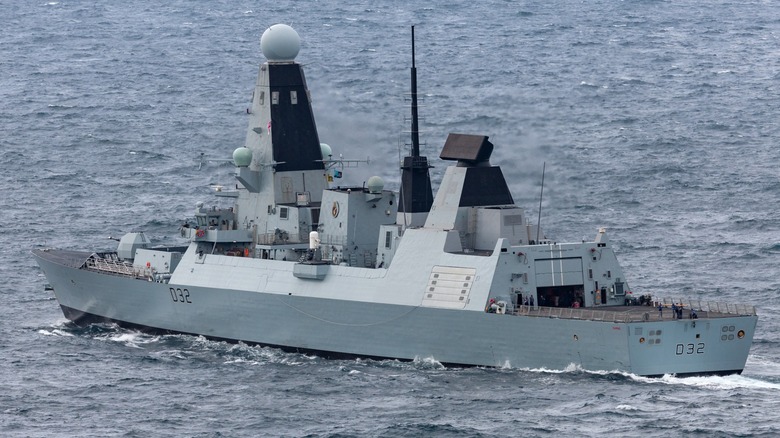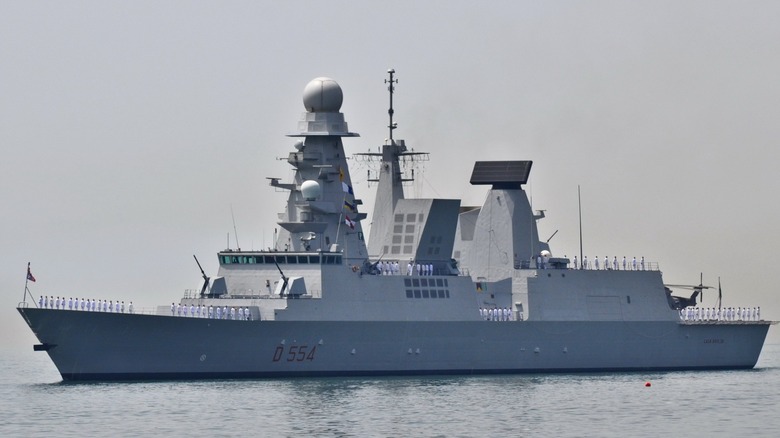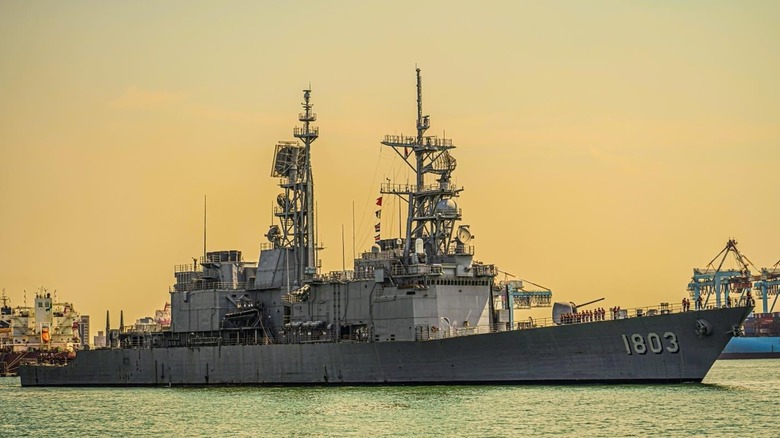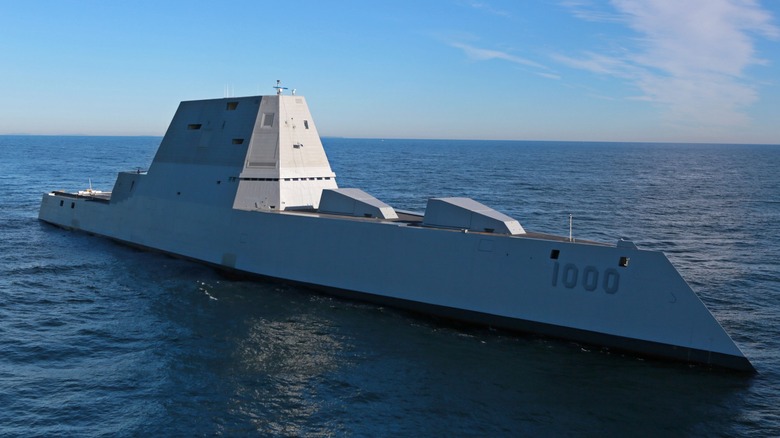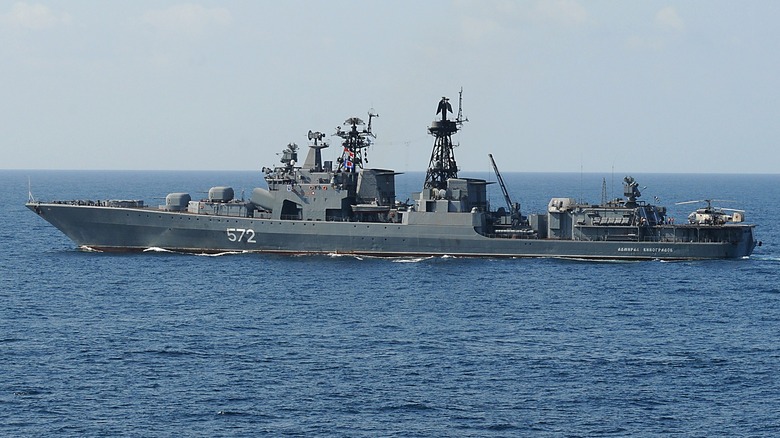12 Of The Most Powerful Navy Destroyers In The World
While the massive aircraft carriers and mysterious submarines of powerful military countries tend to get the most media attention, the often-overlooked destroyer plays an essential role in modern naval operations. The warship, once referred to as a "torpedo boat destroyer," was a fast, maneuverable vessel that primarily provided escort services for larger ships during World War II. In recent years its duties have expanded. Although some are focused on a single type of warfare, most of the top destroyers are equipped as multi-mission surface combatants capable of Anti-Air Warfare (AAW), Anti-Submarine Warfare (ASW), and Anti-Surface Warfare (ASuW).
Modern destroyers have advanced sensors and radars to detect enemies at a long range. The destroyers currently in service in navies around the world today typically have a displacement of 6,000 to 12,000 tons and are equipped with guns as well as long-range missiles to targets at sea, on land, and in the air. These well-equipped vessels can then can operate as a part of a larger battle group or independently.
Many of the top destroyers in the world use similar technology. The American Aegis Weapon System (AWS) combined with the SPY-1 Radar and multi-cell MK-41 Vertical Launch System (VLS) offer excellent flexibility, upgradability, and scalability, keeping today's destroyers relevant and adaptable to future combat requirements. Several Japanese and South Korean vessels have incorporated the U.S. destroyer technology placing them among the best in the world and facilitating cooperative joint naval operations with the U.S. Here are 12 of the most powerful navy destroyers in the world today.
Arleigh Burke class: United States
Named after a World War II American destroyer officer and former Chief of Naval Operations, the Arleigh Burke class destroyers are the foundation of the United States Navy and arguably the best in the world. They maintain superiority on the seas by using cutting-edge command and control systems, advanced radars, and electronic warfare capabilities. First entered into service with the U.S. Navy in 1991, the Arleigh Burke class destroyers have been built in three versions, each with significant technological improvements. The Navy has purchased 92 ships through 2023.
The multi-mission guided-missile destroyers are equally exceptional in all three essential types of warfare with offensive and defensive capabilities in Anti-Air Warfare (AAW), Anti-Submarine Warfare (ASW), and Anti-Surface Warfare (ASuW). Propulsion is provided by four General Electric LM 2500-30 gas turbines generating a total of 100,000 shaft horsepower. Measuring 509 ft long and displacing 9,500 tons, the Flight III Arleigh Burke can reach speeds of 30 knots and has a range of 4,400 nautical miles.
The Arleigh Burke class ships use the state-of-the-art Aegis combat system to integrate the ship's sensors (the AN/SPY-6(V)1 Air and Missile Defense Radar (AMDR) system) with the weapon systems. The offensive and defensive arsenal is exhaustive with an MK-41 Vertical Launching System (VLS) for firing Tomahawk cruise missiles, surface-to-air missiles, anti-submarine warfare missiles, torpedoes, and various close-quarters combat weapons.
Sejong the Great class: South Korea
Sejong the Great class destroyers are designed and built with exceptional technology typical of many South Korean products and are regarded by many to be among the most powerful destroyers in the world. These warships are perhaps best distinguished by their unparalleled stealth technology, carefully designed to minimize radar cross-section and infrared signatures.
Measuring 165 meters long with a beam of 21 meters and a draft of 6 meters, the destroyer has a full load displacement of 10,000 tons making it one of the world's largest destroyers. The ship is powered by a combined gas and gas turbine (COGAG) propulsion system that sends 75 MW of power to two shafts and two controllable pitch propellers, resulting in a top speed of over 30 knots. The Republic of Korea Navy operates three Sejong the Great class destroyers.
Like the Arleigh Burke design, the Sejong the Great class destroyers use the Lockheed Aegis weapon system which includes SPY-1 radar, the MK 99 fire control system, and the MK-41 vertical launching system. The system tracks multiple targets such as aircraft or missiles and responds to these threats. The destroyer is also equipped with the Goalkeeper close-in weapon system (CIWS), anti-submarine rockets, and torpedoes. The massive destroyer can carry two Super Lynx or SH-60 Seahawk helicopters. It also packs more firepower than other dominant destroyers, with 128 missiles compared to 96 missiles on the Arleigh Burke class.
[Featured image by U.S. Navy via Wikimedia Commons | Cropped and scaled | CC BY-SA Public Domain]
Luyang III class: China
The People's Liberation Army Navy (PLAN) of China has made significant progress in the past decade to augment the strength of its naval capabilities. The advances are perhaps best represented by the Luyang III class guided-missile destroyers (Type 052D), which entered service in 2014.
The 052D class measures 157 meters and displaces 7,500 tons with a full load. Power is provided by a combined diesel or gas propulsion system giving the ship a top speed of 30 knots. Equipped with active electronically scanned array (AESA) radar, which uses a computer-controlled antenna array to direct radio waves in different directions, the Chinese destroyer competes well with the most advanced destroyers of the U.S. Navy.
The ship is also fitted with state-of-the-art weaponry for a variety of mission types. These include cruise missiles, surface-to-air missiles, as well as anti-ship and anti-submarine missiles. Two torpedo tubes launch Yu-7 torpedoes, while four 18-tube launchers fire decoy rockets. A helideck can hold a single Kamov Ka-28 or Harbin Z-9C helicopter. As of August 2022, 25 Luyang III class destroyers were in service.
[Featured image by 海防先锋 via Wikimedia Commons | Cropped and scaled | CC BY-SA 4.0]
Kolkata class: India
The Kolkata class destroyers play a key role in India's navy as a deterrent to potentially aggressive adversaries. These destroyers were designed and constructed using state-of-the-art components from sources all over the world. With a displacement of 7,500 tons, the destroyer measures 534 feet long. A combined gas and gas propulsion system employs four Zorya DT-59 gas turbines and two KVM-diesel engines powering the ship to a top speed of 30 knots. The Kolkata class destroyer has a range of 6,000 nautical miles at 18 knots.
The strength of the Kolkata class destroyer's offensive capability can be attributed to its Vertical Launch System, a shipborne missile canister capable of rapid-fire deployment of long-range surface-to-air missiles, anti-ship missiles, and land-attack cruise missiles. The weaponry includes the BrahMos supersonic missile, the fastest cruise missile in the world with a top speed of Mach 2.5 to Mach 2.8.
The destroyer's defense features the MF-STAR multi-function radar for surface and air search, tracking, missile guidance, and gunnery. A Thales LW-08 2D radar provides long-range surveillance. The Barak 8 surface-to-air missile system defends against aerial threats, such as aircraft, helicopters, and incoming missiles. The system is capable of intercepting high-altitude targets as well as supersonic sea-skimming anti-ship missiles.
[Featured image by U.S. Navy via Wikimedia Commons | Cropped and scaled | Public Domain]
Atago class: Japan
In response to missile threats from North Korea and aggressive action by the Chinese, the Japan Maritime Self-Defence Force (JMSDF) increased its Atago class fleet from two ships to four. The Atago was commissioned in March 2007 and the second destroyer, Ashigara, began service in March 2008. The new 10,000-ton destroyers will compensate for Japan's lack of carrier-based jets that could have provided long-range area air defense.
The Atago class destroyer measures 165 meters long and displaces 7,700 tons standard and 10,000 tons with a full load. Power is generated by a Combined Gas and Gas propulsion system with four Ishikawajima-Harima LM2500-30 gas turbines producing a total of 75,000 KW giving the ship a top speed of 30 knots.
The Atago class destroyer is an upgrade over the previous Kongo class. Improved radar systems include the SPY-1D(V) Passive Electronically Scanned Array Radar, the OPS-28E Surface and Air Search Radar, and several others. Weaponry improvements feature the use of the Aegis Combat System and the reliable MK-41 Vertical Launching System used by the best destroyers in the world. The new destroyers will also carry exo-atmospheric ballistic missiles capable of performing hit-to-kill intercept of ballistic missiles while outside the Earth's atmosphere. The design gives Japan a more offensive military capacity, a deviation from its defensive naval doctrine.
Kongo class: Japan
Japan's fleet of ships includes four Kongo class destroyers featuring the Aegis Weapon System (AWS), a centralized, automated, command-and-control system that is often classified as the best in the world. The U.S. Navy Arleigh Burke class destroyer uses the same combat system. Although the Kongo class ships lack the latest technology found in Japan's top-of-the-line Atago class destroyers, they are still some of the most powerful in the world.
Slightly shorter than the 165 meter JMSDF Atago class destroyers, the Kongo class measures 161 meters and displaces 7,500 tons standard and 9,500 tons with a full load. Power is provided by a combined gas and gas propulsion system composed of four Ishikawajima-Harima LM2500 gas turbines sending 75MW to two shafts that propel it to a top speed of 30 knots.
The Kongo class is equipped with three principal radar systems: the SPY-1D air search, the OPS-28 surface search, and a missile director radar. The destroyer is fitted with the MK-41 vertical-launching system that can carry 90 RIM-66 SM-2MR block II surface-to-air missiles. The weapons array also includes RGM-84 Harpoon anti-ship missiles, two Type 68 triple torpedo tubes that can launch six MK46 or Type 73 torpedoes, and a 127mm 54-caliber Oto-Breda compact gun that fires 40 rounds per minute.
[Featured image by James G. McCarter via Wikimedia Commons | Cropped and scaled | Public Domain]
Akizuki class: Japan
The Akizuki class destroyer measures 150.5 meters in length and displaces 5,000 tons standard. Despite its smaller size, the Akizuki class employs a high level of technology including the advanced Command, Control, Communications, Computers, Intelligence, Surveillance and Reconnaissance (C4ISR) system, and Anti-Aircraft Warfare (AAW) capability. Both have been upgraded with the addition of an OYQ-11 advanced Combat Direction Sub-system (CDS) and FCS-3A AAW weapon sub-system.
A Combined Gas and Gas (COGAG) propulsion system features four upgraded Rolls-Royce Spey SM1C gas turbines that incorporate the latest digital control technology and allow the Akizuki class destroyer to reach a top speed of 30 knots.
Developed from the Takanami Class destroyer, the Akizuki class was designed to escort JMSDF warships, including the Atago and Kongo class Aegis destroyers, during ballistic missile defense operations. The ships also escort the Hyuga and Izumo helicopter destroyers. Akizuki Class weapon systems include eight Type 90 ship-to-ship missiles, the MK-41 vertical launch system to fire RIM-162 Evolved Sea Sparrow Missiles, RUM-139 VL-ASROC (an all-weather, quick reaction anti-submarine weapon), and the Type 07 VL-ASROC anti-submarine weapon.
[Featured image by Saigen Jiro via Wikimedia Commons | Cropped and scaled | CC0 1.0 Universal Public Domain]
Type 45: United Kingdom
BAE Systems Surface Ships built the Type 45 — also known as Daring class destroyers — for the British Royal Navy. The first ship, HMS Daring, was commissioned in July 2009. They are the largest and most advanced guided-missile destroyers in the Royal Navy fleet. Measuring 152 meters long with a beam of 21 meters and a draft of 7 meters, the destroyer displaces 8,500 tons with a full load. The ship uses an Integrated Electric Propulsion (IEP) system that sends power to two shafts for a top speed of more than 32 knots.
The Daring class destroyers are armed with a vertical launch system capable of firing 48 Aster 15 and Aster 30 missiles. The ship was originally equipped with eight inclined tube launchers for Harpoon anti-ship missiles. Two 30 mm cannons are used mainly when encountering small craft, and a BAE Mark 8 gun is employed when engaging surface targets and for shore assaults during amphibious landings.
Defensive sensors feature the Sampson multi-function radar. The two-faced rotating radar is enclosed in a spherical radome and uses adaptive digital beamforming techniques to negate clutter and combat high electronic countermeasure environments. Although the Type 45 destroyers could have been built as multirole platforms the Royal Navy chose to create a single-role warship with anti-air capability only.
Horizon class: France/Italy
Both Italy and France replaced their aging destroyers (Audace class destroyers in Italy and Suffren class carrier escorts in France) with the Horizon class. A joint venture between the two countries, the destroyer features the Principal Anti-Air Missile System (PAAMS). The destroyer displaces 7,050 tons with a full load and reaches 152 meters in length. A Combined Diesel or Gas (COGAG) propulsion system consisting of two LM2500 gas turbines and two Pielstick diesel engines gives the ship a top speed of 29 knots.
The Horizon class destroyer is equipped with sophisticated radar systems for surface/air search, target tracking, and missile guidance. These include the European Multifunction Phased Array Radar (EMPAR), a single-faced passive electronically scanning array radar. For long-range detection and early warning of aerial targets, the ship uses the S1850M L-band volume search PESA radar. The Italian destroyer is fitted with Selex RAN 30X/I for surface search radar.
The French and Italian versions differ slightly in armament. Both are equipped with a 48-cell vertical launch system for launching Aster 15 (50+ km range) and Aster 30 (120+ km range) missiles. Eight inclined tube launchers fire Exocet anti-ship missiles on the French ship while eight inclined tube launchers are used for Otomat anti-ship missiles on the Italian destroyer. Both the French and Italian ships have two single torpedo tubes to launch MU90 Impact lightweight torpedoes.
[Featured image by Armando Mancini via Wikimedia Commons | Cropped and scaled | CC BY-SA 2.0]
Kee Lung class: Taiwan
Four ships make up the Kee Lung class (formerly called the Kidd class) of destroyers. While currently in the service with the Taiwanese Navy, the ships were originally built for Iran. The U.S. Navy acquired the destroyers after the contract with Iran was canceled and subsequently sold them to Taiwan in 2001. The $732 million purchase included equipment enhancements, overhaul of some systems, activation, and crew training.
Measuring 172 meters long, the Kee Lung class destroyer displaces 6,950 tons standard and can accommodate 363 marines. The ship is powered by a gas turbine propulsion system with four LM-2500 marine gas turbines producing 80,000 hp that drive two shafts with reversible pitch propellers. The system pushes the destroyer to a maximum speed exceeding 30 knots. The destroyers are designed for anti-air, anti-submarine, and anti-surface warfare, and to support amphibious landing exercises. They are also fitted with advanced air intake and filtration systems designed to manage the excessive dust and sand of the Persian Gulf waters.
The Kee Lung class weaponry features two 127mm guns, two close-in weapon systems, two MK26 launchers firing RIM-66 surface-to-air missiles, and two MK141 quadruple canisters for Harpoon long-range anti-ship missiles. The armament also includes two Mark 32, 324mm triple torpedo tubes that launch MK46 torpedoes capable of engaging submarines within a range of 11 km. The flight deck hosts two medium-lift helicopters equipped for anti-submarine warfare in an enclosed hangar.
[Featured image by ROCN via Wikimedia Commons | Cropped and scaled | Public Domian]
Zumwalt class: United States
The U.S. Navy Zumwalt class is the world's largest destroyer, measuring 190 meters in length and 25 meters in width. The ship was designed with stealth features for use in anti-air, anti-submarine, anti-surface warfare, and littoral military actions. The Navy intended to build 32 of the new destroyers making them the high-tech standard for future naval fleets.
Construction began in 2009. One ship, the USS Zumwalt, is finished, while a second ship, the USS Michael Monsoor, lacks combat equipment, and the third, the USS Lyndon B. Johnson, is still being built. Initial estimates were $1.34 billion per ship for a total project cost of $46 billion for 32 destroyers. However, spiraling costs reached an average of $7 billion for each of the three Zumwalt destroyers in various stages of production, and the project was canceled.
The Zumwalt class destroyers incorporate upgraded features over those found on traditional destroyers and despite the scaled-down endeavor, they have become a testbed for new technologies. The Zumwalt is built with a "tumblehome" hull form giving it enhanced stability in rough seas. The shape and seamless construction add to its stealth characteristic, significantly reducing the destroyer's radar signature. While traditional destroyer propulsion systems use gas turbines, the Zumwalt combines them with electric propulsion allowing the ship to operate on electric power alone at low speeds.
While the project may not have played out as planned, the Zumwalt is also an ideal platform for testing new weaponry, including the addition of oversized hypersonic missiles, requiring a modification to the current Vertical Launch System.
Udaloy class: Russia
The Udaloy class destroyer is the go-to warship of the Russian navy. Built under the control of the collapsed Soviet Union beginning in July 1977, 13 were completed and still provide versatile and reliable support for long-range operations despite their age. Designed as large anti-submarine combatants, the Udaloy class destroyers compare well in size to the U.S. Spruance class ships.
Measuring 163 meters long with a beam of 19 meters, the warship displaces about 7,000 tons standard. The ship is powered by a combined gas and gas (COGAG) propulsion system consisting of two M62 cruise gas turbines and two M8KF boost gas turbines. This helps Udaloy destroyers reach a top speed of 28 knots.
While the Udaloy class destroyers are not identically equipped, the sensors and weapons are specialized for anti-submarine warfare. The ships are fitted with an MGK-355 Polinom sonar suite, although the Udaloy II class uses the more modern Zvezda M-2 sonar system. Anti-submarine weaponry also features two torpedo tubes and depth charges are fired from two RBU-6000 12-round ASW rocket launchers. The Russian navy has recently undergone a modernization program to add better anti-ship weapons, including anti-ship missiles. The new Tsirkon hypersonic missile may be part of future upgrades.
[Featured image by Jason R. Zalasky via Wikimedia Commons | Cropped and scaled | Public Domain]
